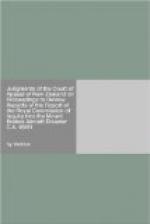The Chief Inspector of Air Accidents, Mr R. Chippindale, carried out an investigation and made a report to the Minister, dated 31 May 1980, under reg. 16 of the Civil Aviation (Accident Investigation) Regulations 1978. It was approved by the Minister for release as a public document. The Chief Inspector concluded that ’The probable cause of the accident was the decision of the captain to continue the flight at low level toward an area of poor surface and horizon definition when the crew was not certain of their position and the subsequent inability to detect the rising terrain which intercepted the aircraft’s flight path’. He adhered to this in evidence before the subsequent Royal Commission.
The Royal Commission was appointed on 11 June 1980 to inquire into ’the causes and circumstances of the crash’, an expression which was elaborated in terms of reference consisting of paragraphs (a) to (j). Mr. Justice Mahon was appointed sole Commissioner. In his report, transmitted to the Governor-General by letter dated 16 April 1981 and subsequently presented to the House of Representatives by Command of His Excellency and later printed for public sale, the Commissioner found that ’... the single dominant and effective cause of the disaster was the mistake made by those airline officials who programmed the aircraft to fly directly at Mt. Erebus and omitted to tell the aircrew’. He exonerated the crew from any error contributing to the disaster.
The Commissioner and the Chief Inspector were at one in concluding that the crash has occurred in a whiteout. The Commissioner gave this vivid reconstruction in the course of para. 40 of his report:
I have already made it clear that the aircraft struck the lower slopes of Mt. Erebus whilst flying in clear air. The DC10 was at the time flying under a total cloud cover which extended forward until it met the mountain-side at an altitude of somewhere between 2000 and 2500 feet. The position of the sun at the time of impact was directly behind the aircraft, being in a position approximately to the true north of the mountain and shining at an inclination of 34 deg. The co-existence of these factors produced without doubt the classic ‘whiteout’ phenomenon which occurs from time to time in polar regions, or in any terrain totally covered by snow. Very extensive evidence was received by the Commission as to the occurrence and the consequences of this weather phenomenon. So long as the view ahead from the flight deck of an aircraft flying over snow under a solid overcast does not exhibit any rock, or tree, or other landmark which can offer a guide as to sloping or uneven ground, then the snow-covered terrain ahead of the aircraft will invariably appear to be flat. Slopes and ridges will disappear. The line of vision from the flight deck towards the horizon (if there is one) will actually portray a white even expanse which is uniformly level.
What this air crew saw ahead of them




